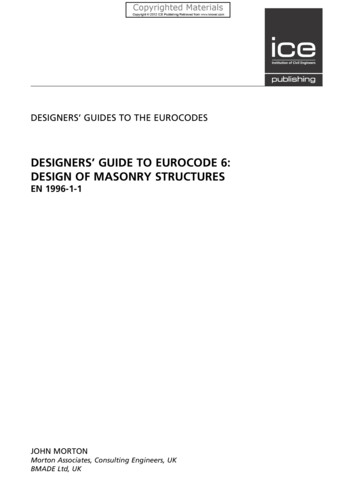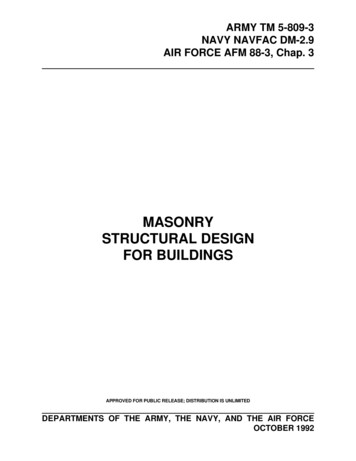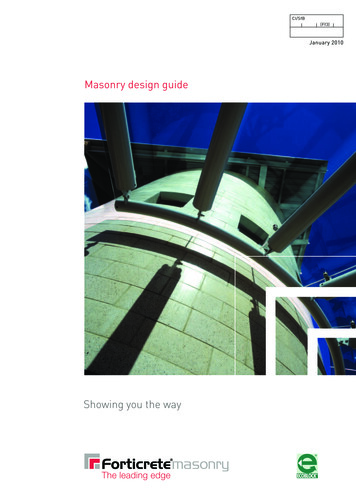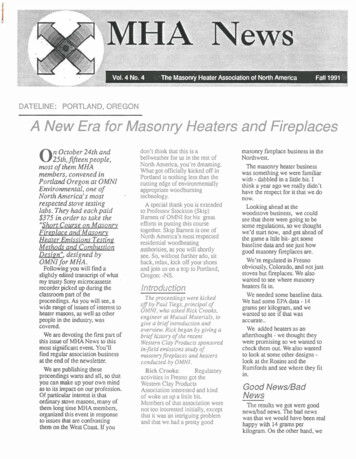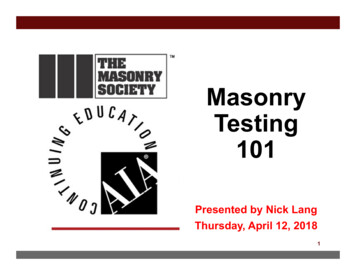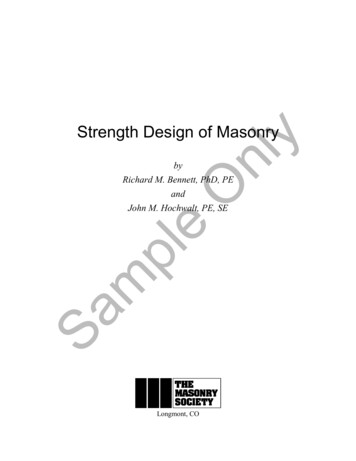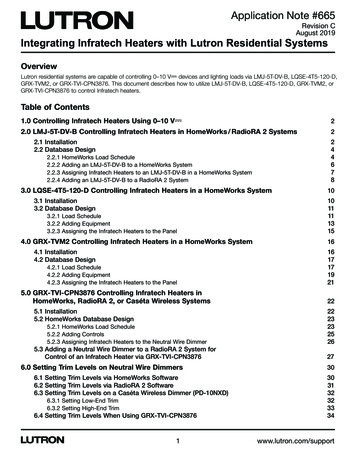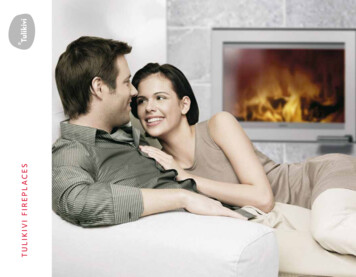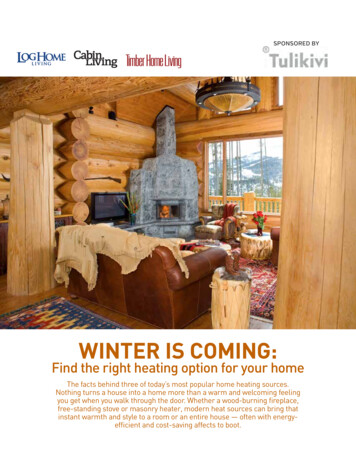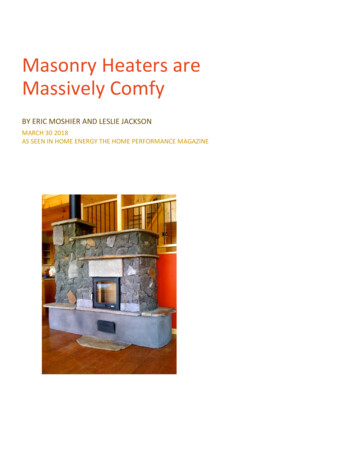
Transcription
Masonry Heaters areMassively ComfyBY ERIC MOSHIER AND LESLIE JACKSONMARCH 30 2018AS SEEN IN HOME ENERGY THE HOME PERFORMANCE MAGAZINE
You enter the house on a winter’s evening, remove your wet boots and coat. In your living room,there are a few pieces of split, dry firewood, ready to burn. You open the door to the firebox,build a fire. You shut the door, and go about your evening.The heater purrs away. That one fire lasts 45 minutes to an hour and a half. It’s the only fireyou’ll build until tomorrow night—maybe tomorrow morning, if it’s especially cold. That heater,with the small, hot fire in it, and the heat stored in the mass of bricks or stone, cost you a high upfront cost. But the initial outlay of 15k or so has in about nine years paid for itself in fuelsavings. Add one year for learning that you need to order your wood in May to start drying it(not in September, when you think about being cold). In a few years, you might spend 10 on anew grate, or 150–250 on a chimney cleaning. In 50 or 60 years, your descendants areconsidering some maintenance (a three-to-four-hour job: 600). And in 100 years, someone isstill enjoying that heater, and paying around 600 per year (today’s prices) for fuel.Moshier built this masonry heater for a client in the Upper Peninsula of Michigan.But the economics aren’t your measure; your comfort is.Few people, especially in the warmer climates in North America, know about the masonryheater, but it is a household word in the colder parts of Northern Europe, and Asia, and an oldone. Stonemason Eric Moshier of Solid Rock Masonry built four heaters this winter and taught
four workshops on them. He stays busy; there aren’t many professional masonry heater buildersin the United States, “probably fewer than one per state,” he says. Yet look in the Austrian phonebook for a stove fitter, as they are called there, and you’ll find 20 to 40 in a medium-sized city.Why so many for a country the size of Wisconsin? It’s more than how cold it is, and it’s certainlynot for lack of technical innovations. It’s how efficient these masonry heaters are as heaters, foran enormous payback of comfort, with very low emissions, burning very little fuel (in a countrywhere firewood resources are limited). Could we enjoy these heaters as much in North America,even if we have plenty of firewood?The heart of a masonry heater is a firebox constructed out of a refractory material such asfirebrick. As the fire burns, the gases move through the heat-exchange channels inside the heater.The warmth is absorbed by the masonry and radiates throughout the home long after the fire hasgone out—often for as long as 24 hours.Lean on me.An Old Solution to an Old ProblemWhen the European versions of these heaters originated, (in the 15th to 18th centuries) scarcity,risk of fire, and the cost of wood were the mothers of invention. People devised ways to get themost out of the little fuel they had, to survive the extremely cold winters. And some of their bestdesigns are still in use today. The key is to burn all the gases in the wood at high temperatures,and store the heat you produce in a thermal battery.Take a standard Contraflow heater, traditional and still popular in Northern Europe. Weighing inat up to 3 tons and standing as high as 9 feet, this heater can be finished with clay plaster, tile,
stone, soapstone, or exposed brick. Efficiency for this heater hovers around 73–78%. Maximumefficiency is about 85%, since you will always lose 10-15% in moisture in the wood, and noheater is designed perfectly. This is because there needs to be a balance between the size of thefirebox, the amount of channels, and the mass or area of the heater, and this balance can’t ever be100% perfect.Austrian Kachelofen or Tile Stove showing the Engine or Core of the unit with some of thechanneling.Typical Kachelofen showing the gas path.
A peek into the complex workings of a Moshier-built kachelofen, or traditional Austrian/Germanheater, finished with kachln tile.Measurable CozinessAfter a heat-loss calculation, Moshier may determine that a given 1,000 ft2 house needs 7,000Btu per hour to satisfy its heating needs. He’ll size the firebox to provide that output. (Maximumheat output on a really large heater, in case you’re wondering, is about 25,000 Btu per hour.)
Testing helps to establish how a masonry heater performs with respect to particulate emissions,combustion efficiency, and overall efficiency. In terms of masonry heaters, combustionefficiency describes how completely the heater is burning the cordwood fuel load. Overallefficiency describes how well the stove transfers energy released from combustion of the woodfuel source into usable heat energy radiated from the heater.Moshier installed this heater in a timber frame home and finished the bricks with earthen plaster.To measure temperatures in the oven and the external brick or stone, Moshier uses a laserthermometer that you can buy for 40 from your local auto parts store. They are not used tomeasure temperatures inside the firebox, which can reach 1,800–2,000 F.
This high temperature is a major player in the resulting efficiency, because most of the volatileorganics in wood don’t burn until they reach at least 1,100 F. The materials of the firebox, thecorrect size of the box, and oxygen introduced at just the right locations in the firebox give you acombustion efficiency of around 98%, with just fly ash left, and a particulate measure of cleancombustion of 0.4 to 2 grams per hour.learn moreLearn to build masonry heaters, find a contractor in your area, be inspired by beautiful pictures,or pore over test results at The Masonry Heaters Association website.Learn more about Eric Moshier’s Solid Rock Masonry.Lyle, David. The Book of Masonry Stoves: Rediscovering an Old Way of Warming. Baltimore:Brick House Publishing, 1984.Read more about test procedures and results for measuring PM.Emissions are not measured with a 40 tool, but with a 3,000 tool called a Testo Fuel GasAnalyzer and a Condar Unit. Particulates, alternatively referred to as particulate matter (PM) orfine particles, are tiny particles of solid or liquid suspended in a gas. In the case of wood burning,PM refers to particulates in exhaust gases (smoke) that exit the chimney and enter theatmosphere. PM consists of ash, and other organic compounds. Testing for R&D research isdone with fairly expensive moisture meters, thermocouples, very accurate scales for measuringsoot. A Testo Combustion Analyzer and a Condar Unit for sucking in the PM to weigh a filter ona scale with accuracy of .001g.It’s notable that these craftsman-built, custom-fit heaters cost the same in Austria as they do herein the United States. It’s not as if they were cheaper there just because everyone has one. Forthose of us who take pleasure in interacting with our sources of energy, and the systems in ourhomes, or who simply like to light fires, here is a guilt-free source of heat we can save up for.Eric Moshier is a stovemason and educator. He runs a family business in Minnesota calledSolid Rock Masonry. Leslie Jackson is Associate Editor and Office Manager at Home Energymagazine.
The heart of a masonry heater is a firebox constructed out of a refractory material such as firebrick. As the fire burns, the gases move through the heat-exchange channels inside the heater. . designs are still in use today. The key is to burn all the gases in the wood at high temperatu
